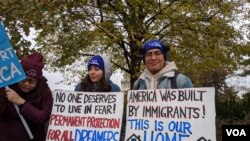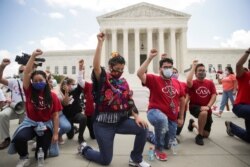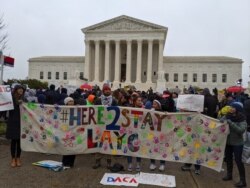On June 18, the U.S. Supreme Court rejected the Trump administration's attempt to end the Deferred Action for Childhood Arrivals program (known as DACA), temporarily protecting some 700,000 people who arrived in the country as young undocumented, immigrants.
Shortly after the decision came out, Sen. Mike Lee, a Utah Republican, said on Twitter: "The Supreme Court held today that President Obama’s DACA program is clearly illegal.”
The statement is false.
Three of the four justices who dissented from the ruling indeed argued that the DACA program was illegal. Justice Clarence Thomas, for example, said: “DHS created DACA during the Obama administration without any statutory authorization and without going through the requisite rule making process. As a result, the program was unlawful from its inception.”
However, that wasn’t the pivotal issue in this ruling. Instead, the court’s majority narrowly decided whether the Trump administration “complied with the procedural requirement that it provide a reasoned explanation” to justify repealing DACA.
Led by Chief Justice John Roberts, the majority found that the administration did not comply, and that its justification was therefore “arbitrary and capricious.” The administration, it said, failed to adequately consider all the impacts of repeal on the economy and DACA recipients who had started families, enrolled in college and launched careers, among other things.
The administration “should have considered those matters but did not,” Roberts wrote.
Still, the majority opinion affirmed that President Donald Trump has the legal authority to repeal DACA. “The dispute before the Court is not whether DHS may rescind DACA. All parties agree that it may,” the majority opinion says. “The dispute is instead primarily about the procedure the agency followed in doing so.”
The next day, Trump tweeted his intent to again move ahead with repeal: "We will be submitting enhanced papers shortly in order to properly fulfill the Supreme Court’s ruling & request of yesterday."
Experts said that it is unlikely to happen before the Nov. 3 presidential election.
Lee's tweet and similar reaction to the court ruling are part of a contentious dispute that began when former President Barack Obama instituted the DACA program in 2012.
Since the early 2000s, the fate of children who crossed into the U.S. illegally has been a topic of heated debate. In 2001, the DREAM Act, aiming to give them a legal path to citizenship, was first introduced in the U.S. Congress, but it languished there for more than a decade. (DREAM stands for Development, Relief and Education for Alien Minors.)
Using his administrative powers, Obama sought to address the matter by offering children temporary protection (two years) from deportation and a permit to legally work in the country, as well as the possibility to renew both protections after they had expired.
In order to qualify, the Dreamers, as the young immigrants became known, had to be under 30, must have arrived in the U.S. before 2007, be in school or graduated, have a clean criminal record and pose no threat to national security or public safety. The program offered benefits such as access to driver’s licenses and in some cases health insurance, but not a path to citizenship.
Trump had called the DACA order illegal from the beginning of his presidential campaign in 2015. Ten months after his election, in September of 2017, then-Attorney General Jeff Sessions announced the DACA program would be phased out, calling it an “unconstitutional exercise of authority by the Executive Branch.”
That year, the U.S. Department of Homeland Security (DHS) stopped accepting new DACA applications and, in 2018, then-DHS Secretary Kirstjen Nielsen said the program should end for there to be “clear, consistent, and transparent enforcement of the immigration laws.”
The executive branch cannot grant lawful status to immigrants. That power is reserved for Congress. But the executive does have the authority to make decisions regarding the lawful presence of immigrants, and it's not uncommon for presidents to grant temporary protections.
In 1987, President Ronald Reagan’s administration announced blanket deferrals of deportation for children of some non-citizens. In 1990, President George H. W. Bush expanded deferred deportation to cover spouses and children of those in the process of acquiring legal status under immigration reforms passed in 1986. That protected as many as 1.5 million people.
More recently, in 2005, President George W. Bush allowed international students who were affected by Hurricane Katrina to apply for delayed deportation.
According to Sarah Paoletti, a professor at the University of Pennsylvania Carey Law School and expert on asylum law, the issue is how far this executive power can go.
"Basically, the question is, what is the authority of the executive to exercise prosecutorial discretion? And the issue that often gets conflated in discussing DACA is the distinction between lawful presence and lawful status," Paoletti told Polygraph.info in an interview.
Given the impracticality of deporting the millions of illegal immigrants in the U.S., DACA was aimed at "articulating who is and who is not a priority for deportation," Paoletti said.
Trump ran for president in 2016 on promises to build a wall on the U.S. southern border. As caravans of immigrants arrived over the next two years, many fleeing poverty and crime in Mexico and Central American, his "zero tolerance policy" created a huge controversy when children were separated from their parents after being detained at the U.S.-Mexican border.
Paoletti said that globally, the court’s decision will likely be interpreted in that historical context. “It can be viewed by the international community as he got stopped this time,” she said.
Chad Wolf, the current secretary of homeland security, said Trump asked him to take steps to comply with the court’s ruling and provide a sufficient rationale for rescinding DACA. The court said DHS failed to meet requirements of the Administrative Procedures Act, a law that governs the deliberations federal agencies must make when taking official actions.
“We need to find a solution for this population,” Wolf said on NBC’s “Meet the Press.” He said the administration was willing to work with Congress.
“At no point in that decision did (the justices) say that the program was lawful,” Wolf added. “They simply didn't like the rationale and the procedures that we used. And I find that a little troubling.”
The Democratic House passed a bill last year to give Dreamers a path to citizenship, but the Republican Senate hasn’t taken up the measure. Action is unlikely in a presidential election year.
In his tweet, Lee complained that the court should have ended the matter: “If a president can’t undo the illegal acts of his predecessor, that can lead only to ever-expanding executive power.”
Lee’s wasn’t the only statement that glossed over the nuance in the court’s ruling.
Joseph Edlow, the U.S. Citizenship and Immigration Services deputy director for policy, issued a statement saying the “court opinion has no basis in law and merely delays the President’s lawful ability to end the illegal Deferred Action for Childhood Arrivals amnesty program.”
The statement goes on to repeat the administration’s claim – not decided in the court case – that Obama exceeded his authority in creating the DACA program.
“We do not decide whether DACA or its rescission are sound policies,” Roberts wrote in the opinion. “We address only whether the agency complied with the procedural requirement that it provide a reasoned explanation for its action.”
In his dissent, Justice Thomas said the majority opinion punted. “Today’s decision must be recognized for what it is: an effort to avoid a politically controversial but legally correct decision,” he wrote.









